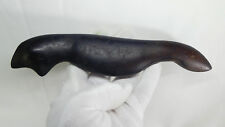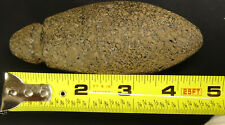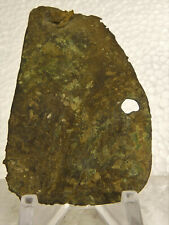X-RARE Shaman Transformation Gorget w/35+ Pictographs Native American Hopewell

When you click on links to various merchants on this site and make a purchase, this can result in this site earning a commission. Affiliate programs and affiliations include, but are not limited to, the eBay Partner Network.
X-RARE Shaman Transformation Gorget w/35+ Pictographs Native American Hopewell:
$4950.00
Ancient Civilizations
Ancient Art, Antiques & FineCollectibles
AncientNative American Shaman’s Copper Gorget
Estimated35+ Images of Shaman Transformation Figures
Hopewell Tradition
c.200 BC—500 AD
Note:
I certify that this Ancient Copper Gorget was legally collected on private land with the owner's permission prior to 1970 and no Native American caves or mounds were disturbed. This is an opportunity to legally own a Shaman's Native American Copper Gorget that is estimated to be about 1500 to 2,200 years-old.
The Hopewell Tradition (also incorrectlycalled the "Hopewell Culture") is the term used to describe commonaspects of the Native American culture that flourished along rivers in thenorthEastern and Midwestern United States from 200 BC to 500 AD. The Hopewelltradition was not a single culture or society, but a widely dispersed set ofrelated populations, which were connected by a common network of trade routes,known as the Hopewell Exchange System.
Summary
Item: Native American Shaman’s Copper Gorgetwith at least 35+ Transformation Images, including: Shaman, Spirits, Hands, Animals, Birds, Insects,& Spirit Animals.
Tribe: Hopewell Tradition
Est. Date:200 BC—500 AD
Material: Copper hammered into a thinsheet, painted, and then punched with two suspension holes.
Measurements: 2.93” (74 mm) long x 1.69”(43 mm) wide x .04” (1.15 mm) thick
Condition:Very good period condition with no cleaning, repairs, or restorations,although the top edge appears to have broken off in antiquity. Exhibits signs of age such as surface wear,oxidation, lichen growth, and weathering. Original copper patina with leather knot stillattached in one of the suspension holes.
Provenance: This piece came from a large, privatecollection of Native American artifacts in Pennsylvania, including Iroquoiseffigy clubs, Anasazi pottery, Mississippian, and Hopewell artifacts.
Details
Although the exact significance of the human,animal, and insect images, which had been painted on about 1,500 to 2,000years-ago on both sides of this gorget pendant is unknown, it appears that itwas owned by a shaman who was able to communicate with the Spirit World bytransforming himself into an animal spirit.Both sides of the gorget have painted images that can still be faintlyviewed, especially under magnification.
On the obverse side of this gorget (withthe side hole facing right), there appears to be at least eight (8) pictographsthat were painted on to the once bright copper surface and are now covered overwith lichen and copper oxidation, but they include: {See photos # 1, 4-6}
·A standing Shaman man with legs separatedand with his arms upraised to the Sun God.He appears to be wearing a feathered headdress, which was common forShaman—see additional details in the Shaman section below.
·Underneath the Shaman on the lowerright side, is a pair of raised hands with fingers. The hand was a symbol of possession orownership, and in this case may represent spiritual ownership, perhapssignifying the Shaman’s close bond with his Spirit animal.
·Directly across from the Shaman,there appears to be an insect, possibly a cicada or a butterfly—you can see itstiny front legs and wings next to its elongated body.
·Above the butterfly or cicada (?),there appears to be a small frog with 4 legs.
·And on the very top of this side,there appear to be 3 small pictographs positioned in a horizontal line that measuresabout 19 mm in length, but that I was unable to see clearly enough to identifythe images.
On the reverse side of this gorget (shownwith the side hole facing left), one can see at least six (25) painted figuresof: {See photos # 2, 8-12}
·A seated Shaman with his arms raisedand in transformation pose with his Spirit animals. He is depicted with a characteristic top-knothairstyle--a distinguishing feature of Shamans throughout the Southeast, Woodlands,and even in the Great Plains. On thisimage of a Shaman, one can see his/her braided hair hanging from theirshoulders to the ground.
·This painted figure appears to be ina state of altered consciousness as you can see a tiny stick figure of a human Spiritbeing carried to the skies by a string of perhaps 10 tiny birds as they transformthe Shaman for his astral, out-of-body journey.
·There are a number of images comingfrom the mouth of the Shaman that appear to be two small animals (the largestis just 6 mm long) that could the Shaman’s Spirit Animals or his singing to contactthem.
·An effigy of what appears to be anotherSpirit Animal that is painted below the Shaman.
·Across from the Shaman on the leftside, there appears to be a large bird with its wings spread 23 mm, likely amajestic eagle, and from the size likely the Shaman’s primary Spirit Animal. {Seephoto # 8}
·Above the Eagle, is another figure thatappears to be a four-legged animal.
·On the lower right side, there areperhaps 19+ very tiny images of people (or Spirit Ancestors?), a pot, raisedhands, etc. These pictographic imagesare ridiculously small and had to be painted with a brush made from just a fewstrands of animal fur.
Each shaman was believed to carry withinhim a number of animal spirits that directed and guided hisjudgements—oftentimes represented by a lizard, snake, animals, or birds. Decisions were made on the basis of advicesupposedly received from such supernatural animal helpers.
When a shaman has an out-of-bodytransformation into an animal or bird, these beings are not actual creatures,but spirits that take the form of the animal representing the need of theindividual.
Hopewell Tradition
Hopewell culture, notable ancient Indianculture of the east-central area of North America. It flourished from about 200BC to 500 AD chiefly in what is now southern Ohio, with related groups inMichigan, Wisconsin, Indiana, Illinois, Iowa, Kansas, Pennsylvania, and NewYork. The name is derived from the Hopewell farm in Ross county, Ohio, wherethe first site that explored a group of burial mounds with extensive enclosuresof banked earth was examined. The term Mound Builders, once applied to thisculture, is now considered a misnomer. Later investigations revealed that thepractice of constructing earth mounds was widespread and served greatlydiffering purposes.
Hopewell villages often laid along riversand streams. The inhabitants raised corn (maize) and possibly beans and squash,but still relied upon hunting and fishing and the gathering of wild nuts,fruits, seeds, and roots.
The amount of pottery and ornamentalstonework and metalwork that has been found suggests some division of labor;moreover, the nature and size of the earthworks at many sites suggest thatforms of public labor, whether voluntary or conscripted, may have beenemployed. The earthworks sometimes suggest defensive purposes, but more oftenthey served as burial mounds or apparently formed the bases of temples or otherstructures.
Their metalwork (consisting of beating andannealing) has been called the finest in pre-Columbian North America. Coppersheet was much used; although some silver and meteoric iron, and occasionally gold,entered into various ornaments and utility pieces. Sheets of mica alsocharacterize the culture.Trade routes were evidently welldeveloped, for material from as far away as the Rocky Mountains and the coastsof the Gulf of Mexico and the Atlantic Ocean are found in Hopewell sites, andarticles identified as manufactured by the Hopewell Indians are found inlocalities as far distant.
Shaman in the Hopewell Culture
Although the exact significance of thefigures that decorate both sides of this gorget pendant is unknown, it appears thatit was owned by a shaman who was able to communicate with the Spirit World bytransforming himself into an animal spirit.
Each shaman was believed to carry withinhim a number of animal spirits that directed and guided his judgements—oftentimesrepresented by a lizard or snakes.Decisions were made on the basis of advice supposedly received from suchsupernatural animal helpers.
When a shaman has an out-of-bodytransformation into an animal or bird, these beings are not actual creatures,but spirits that take the form of the animal representing the need of theindividual.
On the obverse side of this gorget, onecan see the painted figure of a kneeling Shaman with his characteristictop-knot hairstyle--a distinguishing feature of shamans throughout theSoutheast, Woodlands, and even in the Great Plains. On this image of a Shaman, one can seehis/her braided hair hanging from their shoulders to the ground. An effigy ofhis patron-spirit animal was painted on the obverse side of this copper gorget. This painted figure appears to be in a stateof altered consciousness as they transform into a spirit animal on theirastral, out-of-body journey.
Shaman controlled the reins of powerovertly exercised by the Chief.Everyone, including the Great Sun Chief himself, was subject to theirultimate authority, and it was through them that punishment was demanded forthe breach of any rules of behavior on ritual occasions, since it was to theSpirit World with which the shamans were in communication that people had toatone for deviations affecting the community, clan, and the individual.
Shaman were able to communicate directlywith the animal-spirits of the supernatural world. In Southeast native beliefs, the frog or toadwas the bringer of rain as well as being a powerful shaman figure. This gorget was probably used by a shamanduring rituals that were intended to appeal to the spirits of rain and thunder.
Birds of prey feature prominently inHopewell shamanic belief, since they are swift, courageous, noiseless, anddeadly efficient. Shaman wore elaborate headdresses that almost always includedfeathers in recognition of the desirable qualities possessed by birds and as anexpression of the shaman’s ability to transform himself into out-of-body traveland fly into the spirit world.
Head coverings were deemed essential, asthis part of the body was thought to be the exit and entry point for the soul.
References
Shamanism in North America,Norman B. Hint, Firefly Books, 2003.
Note:
Each object I sell is professionally researchedand compared with similar objects in the collections of the finest museums in the world. I have been dealing in fine antiquities for almost 50 years and although certainly not an expert in every field, I have been honored to appraise, buy, collect, and enjoy and recently sell some of the finest ancient art in the world. When in doubt, I have worked with dozens of subject matter experts to determine the condition and authenticity of numerous antiquities and antiques. This documentation helps to insure you are buying quality items and helps to protect your investment.
I offer a full Money-Back Guarantee if a recognized authority in antiquities disputes the authenticity of these fine artifacts.
Please ask any questions you may have before you offer!
All sales are Final, unless I have seriously misrepresented this item!
Please look at the 4x macro photos carefully as they are part of the description.
Member of the Authentic Artifact Collectors Association (AACA) & the Archaeological Institute of America (AIA)
Per 's rules, PayPal only please!
FREE USA SHIPPING includes insurance and is accurate for all 50 States!
Note: Washington State buyers are responsible for the Washington State sales tax.
International Buyers are responsible for all shipping, Customs Import Taxes and Duties.
THANK YOU!!!
X-RARE Shaman Transformation Gorget w/35+ Pictographs Native American Hopewell:
$4950.00

Related Items:
X-RARE NW Coast Shaman's Earthquake Serpent Effigy 1800s Pacific NW, WA
$41425.00
X-RARE Osage Nation 4.66" Shaman's Charmstone w/150+ Petroglyphs Missouri. COA
$7250.00
X-RARE Shaman Transformation Gorget w/35+ Pictographs Native American Hopewell
$4950.00







